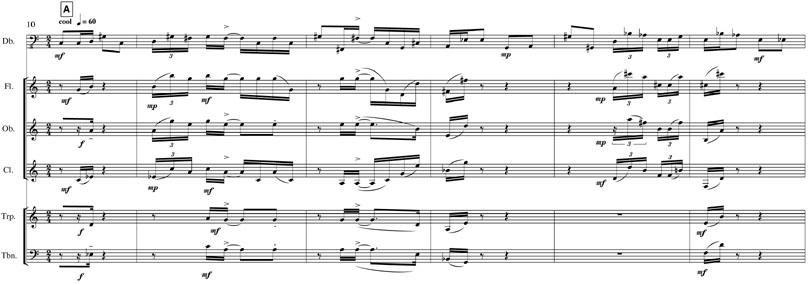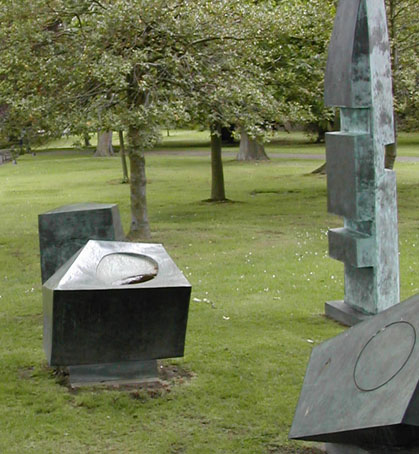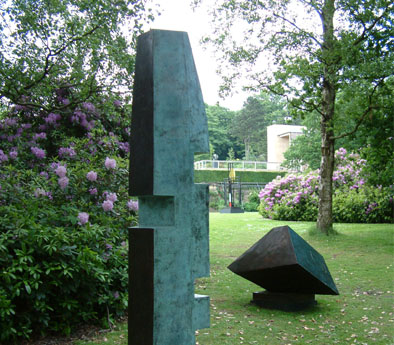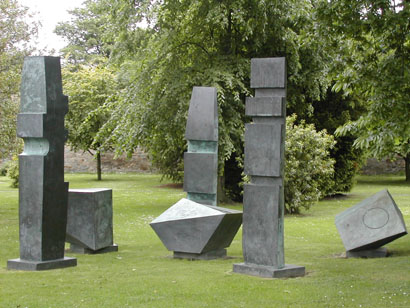[Introduction]
[Ascending Form]
[Conversation with Magic Stones]
[Back to Rhythm of the Stones]

National Orchestra of Wales at YSP on June 14 2003.It was conceived to be played by any contrabass instrument with or without a small ensemble. The compass and tessitura of the solo part makes this possible.
The work is presented initially for double bass, but versions for electric bass guitar, tuba, and contra bassoon are available.
The version presented here is scored for:
![]() Solo Contrabass Instrument
Solo Contrabass Instrument
![]() Flute
Flute
![]() Oboe
Oboe
![]() Clarinet in Bb
Clarinet in Bb
![]() Trumpet in Bb
Trumpet in Bb
![]() Bass Trombone
Bass Trombone
[Introduction]
[Ascending Form]
[Conversation with Magic Stones]
[Back to Rhythm of the Stones]

[Introduction]
[Ascending Form]
[Conversation with Magic Stones]
[Back to Rhythm of the Stones]
Conversation with Magic Stones
A few black and green yews
are where these forms choose,
for privacy or camouflage,
to stage their large self-absorption.
Among them
no bend.
No stoop.
I turn.
The bland
smile of
innuendo
glances
off my back.
Verdigris
mouths
grimace.
But oblique is the glance of the magic stones.
No horizontals but a line of obedient water
where yew needles ride, idle in the shallow
bronze crater in a warm bronze plain.
One stone bends an avian eye
but the other, with lowered gaze,
exposes its receptivity,
its vulnerable fontanelle.

[Introduction]
[Ascending Form]
[Conversation with Magic Stones]
[Back to Rhythm of the Stones]
A figure
confronts
a stone.
Severe
Vedigris
mouth.
Smooth
face, hard.
The stone deflects all words,
with every plane, line and angle
points to escape routes.
I stand where the stones
overlap in my sight
Each seems a child
with an incalculable centre.
There is no end to the secrets
they slip each other.
– Margaret Morgan 2003

[Introduction]
[Ascending Form]
[Conversation with Magic Stones]
[Back to Rhythm of the Stones]

Conversation with Magic Stones is one of a number of works by Nigel Morgan that use source material from Nicholas Slonimksy’s Thesaurus of Scales and Musical Patterns (1947), a collection of several thousand examples much used by jazz musicians and composers. John Coltrane is said to have learnt them all! John Adams recently celebrated their use in his orchestral work Slonimsky’s Earbox. Conversation employs patterns 1 to 5: the tritone progression (an equal division of the octave into two parts) with an interpolation of one note. Other pieces using Slonimsky patterns include the Schizophonia for three remote ensembles, Dreaming Aloud for solo guitar, Rising Falling for solo violin, Interactions for piano (left hand) and interactive computer system, and Slonimsky Studies: Set 1 for piano.Nigel Morgan’s Slonimsky-based compositions are discussed in more detail here.All markings of phrasing, dynamics, tempo and articulations should be considered as initial guides, no more. The full score is written in C.
Downloads
Study score for double bass and ensemble [pdf] Parts [zip]
Solo double bass score [pdf]
Recording (David Langstroth, Double Bass)
I [mp3]
II [mp3]
III [mp3]
IV [mp3]
V [mp3]
